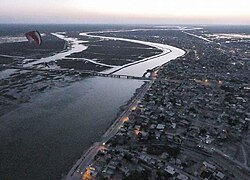History
Al-Chibayish was historically home to a community of Mandaeans, as well as Arabs. In 1895, Sheikh Ṣaḥan ibn Sheikh Ṣagar (Ṣaqar in standard Arabic), a Mandaean priest, was arrested near Chabāyish in Iraq and imprisoned in Basra. He was accused of supporting an Arab tribal rebellion led by Jāsim al-Khayyūn (of the Bani Asad tribe, one of the largest tribes affiliated with the Al-Muntafiq), as well as killing his nephew. Although a petition was delivered to the British authorities to have him released, and the British attempted to assist Sheikh Sahan, he was not released and died in prison in 1898. [3]
Al-Chibayish was the subject of a groundbreaking 1955 ethnographic study, Marsh Dwellers of the Euphrates Delta, by Iraqi anthropologist Shakir Mustafa Salim. [4]
Al-Chibayish was home to about 11,000 people in 1955. [4] Al-Chibayish's population dropped to less than 6,000 by 2003 as a result of Saddam Hussein's draining of the Mesopotamian Marshes and his associated campaign of violence against the Marsh Arabs, during which Al-Chibayish was attacked by military helicopters. [5] However, the population recovered and quintupled between 2001 and 2009, when it reached an estimated 30,416 people. [1]
This page is based on this
Wikipedia article Text is available under the
CC BY-SA 4.0 license; additional terms may apply.
Images, videos and audio are available under their respective licenses.


